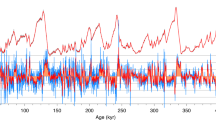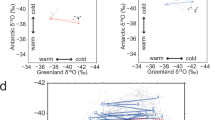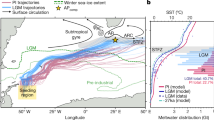Abstract
During the two most recent deglaciations, the Southern Hemisphere warmed before Greenland1,2. At the same time, the northern Atlantic Ocean was exposed to meltwater discharge3, which is generally assumed to reduce the formation of North Atlantic Deep Water4,5. Yet during deglaciation, the Atlantic thermohaline circulation became more vigorous, in the transition from a weak glacial to a strong interglacial mode6. Here we use a three-dimensional ocean circulation model7 to investigate the impact of Southern Ocean warming and the associated sea-ice retreat8 on the Atlantic thermohaline circulation. We find that a gradual warming in the Southern Ocean during deglaciation induces an abrupt resumption of the interglacial mode of the thermohaline circulation, triggered by increased mass transport into the Atlantic Ocean via the warm (Indian Ocean) and cold (Pacific Ocean) water route9,10. This effect prevails over the influence of meltwater discharge, which would oppose a strengthening of the thermohaline circulation. A Southern Ocean trigger for the transition into an interglacial mode of circulation provides a consistent picture of Southern and Northern hemispheric climate change at times of deglaciation, in agreement with the available proxy records.
This is a preview of subscription content, access via your institution
Access options
Subscribe to this journal
Receive 51 print issues and online access
$199.00 per year
only $3.90 per issue
Buy this article
- Purchase on Springer Link
- Instant access to full article PDF
Prices may be subject to local taxes which are calculated during checkout




Similar content being viewed by others
References
Sowers, T. & Bender, M. Climate records covering the last deglaciation. Science 269, 210–214 (1995)
Petit, R. et al. Climate and atmospheric history of the past 420,000 years from the Vostok ice core, Antarctica. Nature 399, 429–436 (1999)
Marshall, J. S. & Clarke, G. K. C. Modelling North American freshwater runoff through the last glacial cycle. Quat. Res. 52, 300–315 (1999)
Stocker, T. F. & Wright, D. G. Rapid transitions of the ocean's deep circulation induced by changes in surface water fluxes. Nature 351, 729–732 (1991)
Maier-Reimer, E., Mikolajewicz, U. & Hasselmann, K. Mean circulation of the Hamburg LSG OGCM and its sensitivity to the thermohaline surface forcing. J. Phys. Oceanogr. 23, 731–757 (1993)
Sarnthein, M. et al. Changes in east Atlantic deepwater circulation over the last 30,000 years: Eight time slice reconstructions. Paleoceanography 9, 209–267 (1994)
Prange, M., Romanova, V. & Lohmann, G. The glacial thermohaline circulation: Stable or unstable? Geophys. Res. Lett. 29, 10.1029/2002GL015337 (2002)
Shemesh, A. et al. Sequence of events during the last deglaciation in Southern Ocean sediments and Antarctic ice cores. Paleoceanography 17, 101029/2000PA000599 (2002)
Gordon, A. L., Weiss, R. F., Smethie, W. M. Jr & Warner, M. J. Thermocline and intermediate water communication between the South Atlantic and Indian Oceans. J. Geophys. Res. 97, 7223–7240 (1992)
Broecker, W. S. The great ocean conveyor. Oceanography 4, 79–89 (1991)
Shin, S. I., Otto-Bliesner, B., Brady, E. C., Kutzbach, J. E. & Harrison, S. P. A simulation of the last glacial maximum climate using the NCAR-CCSM. Clim. Dyn. 20, 127–151 (2003)
Ganopolski, A. & Rahmstorf, S. Rapid changes of glacial climate simulated in a coupled climate model. Nature 409, 153–158 (2001)
Macdonald, A. M. & Wunsch, C. An estimate of global ocean circulation and heat fluxes. Nature 382, 436–439 (1996)
Weijer, W., De Ruijter, W. P. M., Sterl, A. & Drijfhout, S. S. Response of the Atlantic overturning circulation to South Atlantic sources of buoyancy. Glob. Planet. Change 34, 293–311 (2002)
Stommel, H. Thermohaline convection with two stable regimes of flow. Tellus 13, 224–230 (1961)
Stocker, T. F. in Continuum Mechanics and Applications in Geophysics and the Environment (eds Straugham, B., Greeve, R., Ehrentraut, H. & Wang, Y.) 337–367 (Springer, New York, 2001)
Rühlemann, C., Mulitza, S., Müller, P. J., Wefer, G. & Zahn, R. Warming of the tropical Atlantic Ocean and slowdown of thermohaline circulation during the last deglaciation. Nature 402, 511–514 (1999)
Bard, E., Rostek, F., Turon, J. L. & Gendreau, S. Hydrological impact of Heinrich events in the subtropical northeast Atlantic. Science 289, 1321–1324 (2000)
Sachs, J. P., Anderson, R. F. & Lehman, S. J. Glacial surface temperatures of the southeast Atlantic Ocean. Science 293, 2077–2079 (2001)
Crowley, T. J. North Atlantic Deep Water cools the Southern Hemisphere. Paleoceanography 7, 489–497 (1992)
Stephens, B. B. & Keeling, R. F. The influence of Antarctic sea ice on glacial–interglacial CO2 variations. Nature 404, 171–174 (2000)
Toggweiler, J. R. Variation of atmospheric CO2 by ventilation of the ocean's deepest water. Paleoceanography 14, 571–588 (1999)
Lohmann, G. & Schulz, M. Reconciling Bølling warmth with peak deglacial meltwater discharge. Paleoceanography 15, 537–540 (2000)
Schott, W. Die Foraminiferen in dem äquatorialen Teil des Atlantischen Ozeans. Deut. Atl. Exped. Meteor 1925–1927 3, 43–134 (1935)
Berger, W. H. & Wefer, G. in The South Atlantic: Present and Past Circulation (eds Wefer, G., Berger, W. H., Siedler, G. & Webb, D. J.) 363–410 (Springer, Heidelberg, 1996)
Kim, S. J., Crowley, T. J. & Stössel, A. Local orbital forcing of Antarctic climate change during the last interglacial. Science 280, 728–730 (1998)
Koutavas, A., Lynch-Stieglitz, J., Marchitto, T. M. Jr & Sachs, J. P. El Niño-like pattern in ice age tropical Pacific sea surface temperature. Science 297, 226–230 (2002)
Schouten, M. W., De Ruijter, P. M. & van Leeuwen, P. J. Upstream control of Agulhas Ring shedding. J. Geophys. Res. 107 101029/2001JC000804 (2002)
Prange, M., Lohmann, G. & Paul, A. Influence of vertical mixing on the thermohaline hysteresis: Analyses of an OGCM. J. Phys. Oceanogr. 33, 1707–1721 (2003)
Lohmann, G. & Lorenz, S. The hydrological cycle under paleoclimatic boundary conditions as derived from AGCM simulations. J. Geophys. Res. 105, 17417–17436 (2000)
Acknowledgements
We thank H. Jansen, S. Mulitza and M. Prange for suggestions. L. Könnecke, S. Schubert, M. Butzin and S. Blessing are acknowledged for their technical support. This work was supported by BMBF through the DEKLIM project ‘climate transitions’.
Author information
Authors and Affiliations
Corresponding author
Ethics declarations
Competing interests
The authors declare that they have no competing financial interests.
Supplementary information
41586_2003_BFnature01855_MOESM1_ESM.mov
Supplementary Movie 1: Temporal anomaly evolution of salinity, temperature and horizontal velocities between experiment LGM_100 and LGM_CTRL. Temperature and velocity represent surface anomalies. The salinity anomaly is averaged over the upper 800 m. The blue point on the NADW export curve serves for orientation in time. (MOV 1905 kb)
41586_2003_BFnature01855_MOESM2_ESM.mov
Supplementary Movie 2: Temporal evolution of North Atlantic deep water (NADW) convection sites in experiment LGM_100 and horizontal velocity anomaly between experiment LGM_100 and LGM_CTRL at the ocean surface. The blue point on the NADW export curve serves for orientation in time. (MOV 719 kb)
41586_2003_BFnature01855_MOESM3_ESM.pdf
Supplementary Figure: Time Series of NADW export at 30°S for our deglaciation scenarios with alternated wind and temperature forcing. In this set of experiments, the global sea ice cover has been prescribed and the change to interglacial conditions has been applied instantaneously. LGM_SH – changed temperature, sea ice and wind stress; LGM_SH_TICE – changed temperature and sea ice; LGM_SH_WIND – changed wind stress. The experiments with Southern Ocean warming south of 30°S are represented by the red curves. In experiment LGM_NH (green curve), interglacial values in temperature, sea ice and wind stress are applied north of 30°N. The glacial (LGM_CTRL_ICE) and interglacial (PD) reference states are indicated by the black curves and crosses. (PDF 94 kb)
Rights and permissions
About this article
Cite this article
Knorr, G., Lohmann, G. Southern Ocean origin for the resumption of Atlantic thermohaline circulation during deglaciation. Nature 424, 532–536 (2003). https://doi.org/10.1038/nature01855
Received:
Accepted:
Issue Date:
DOI: https://doi.org/10.1038/nature01855
This article is cited by
-
Projected Atlantic overturning slow-down is to be compensated by a strengthened South Atlantic subtropical gyre
Communications Earth & Environment (2023)
-
Southern Ocean glacial conditions and their influence on deglacial events
Nature Reviews Earth & Environment (2023)
-
Indian Ocean salinity build-up primes deglacial ocean circulation recovery
Nature (2023)
-
Identifying the mechanisms of DO-scale oscillations in a GCM: a salt oscillator triggered by the Laurentide ice sheet
Climate Dynamics (2023)
-
Long-term evolution of ocean eddy activity in a warming world
Nature Climate Change (2022)
Comments
By submitting a comment you agree to abide by our Terms and Community Guidelines. If you find something abusive or that does not comply with our terms or guidelines please flag it as inappropriate.



